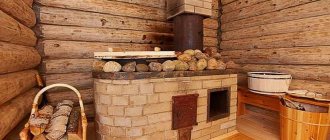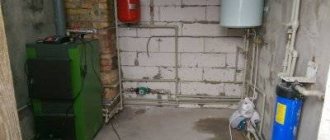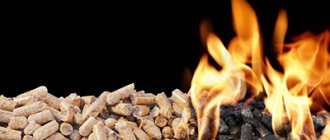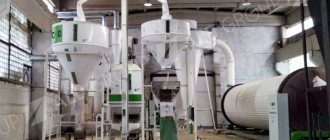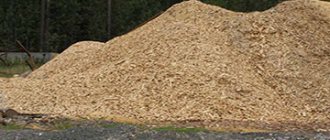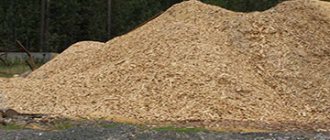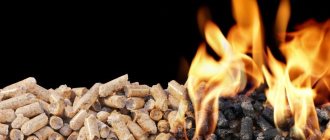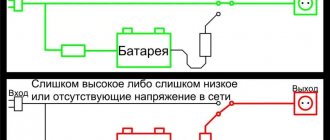Pellet boilers are convenient because they can operate autonomously for a long time. For uninterrupted operation, they only need a guaranteed and uniform supply of fuel. Bunkers are used to store and supply pellets. They come in two types: built into the boiler and free-standing, they are also called “external” or “external”.
Built-in ones are located in the boiler. Their disadvantage is their small volume and, therefore, short operating time without additional fuel loading. The advantage is that there is no need to think about where to place or where to make a bunker.
The built-in pellet hopper has a small volume
Types of bunkers
Essentially, a bunker is a room where fuel is loaded and automatically supplied directly to the boiler.
At the same time, the bunker and boiler must meet many requirements - and, first of all, fire safety rules.
Depending on its characteristics, a pellet bunker is capable of supplying pellets for heating homes and industrial enterprises: from one week to an entire heating season. When choosing a storage facility, consider the boiler parameters.
Stores offer several types of pellet bins:
- Standing alone . The simplest way out of the situation, but not the worst in terms of performance. This type of bunker can operate from several hours to several days, if the volume of loaded pellets allows it.
- Additional bunker . Can increase the life of the boiler to a couple of months. Some time ago, plastic bins appeared on the market.
- A room with a V-shaped floor with slopes . It is a popular way to increase boiler productivity, because. Instead of one bunker, a whole room is used, which you can equip yourself or involve specialists. Benefits include simplicity, increased automation and reduced energy costs for feeding pellets. The disadvantage is the fact of space deprivation: approximately 20% of the storage volume. In most cases, special hatches or a twin-screw transmission are used to load pellets. Fuel is placed throughout the entire area of the room using augers; it is also possible to use a vacuum pump.
- Underground storage . The most difficult storage to implement. The bunker should be located at the same level as the boiler room: in the basement. All this leads to the need for careful calculations, smart design and selection of a suitable location.
However, despite all the difficulties, an underground bunker has some advantages:
- firstly, ease of loading: it is carried out through a hatch opening to the surface;
- secondly, the underground bunker is located at some distance from the building and is not closely adjacent, which increases fire safety and prevents sudden fire. A vacuum pump or augers are used to feed pellets into the boiler.
How to do
Making containers yourself is not particularly difficult. You can make a frame from a metal corner, cover it with boards, plywood, weld metal of the appropriate shape to the corner, etc. What you need to pay attention to when developing the design is that most bins have at least one inclined wall, which guarantees uniform pouring of granules. There may be more difficulties with a screw device, but you can always buy a ready-made one. It will still be cheaper than buying a branded one. For example, a MAFA Mini bunker with a volume of 300 liters costs 500 euros, a bunker from the same company, but with a volume of 750 liters costs 900 euros.
It’s easy to make a pellet hopper yourself
To manufacture a screw device, you need: a screw of the required length and diameter of 75-100 mm (2), a metal pipe of a larger diameter than the screw (1), a motor that is controlled from the burner (3). We insert the auger inside the pipe, connect the motor, and insert the pipe into the hole in the lower part of the pellet hopper.
Screw device
There are no particular difficulties foreseen in the manufacture of a pellet bunker. No special technique or any supernatural abilities are needed here. Sometimes the so-called “locking” effect occurs when the pellets “hang” at a certain height. The problem is solved with a “tedder”: a small-diameter pipe to which not very long pieces of wire are welded. This “tedder” is connected to a separate motor.
Pellet hopper with tedder
If desired, the presence/absence of pellets in the bunker can be monitored with special sensors. But this capability is usually implemented in large volume silos that are rarely visited and inspected. What types of pellets are there, what is their difference, read the article Pellets for heating: types and features of use.
Fire safety rules
Since the bunker is designed to store fuel, which is highly flammable, you must follow simple rules to minimize the risk of fire:
- loading the room to the top;
- ventilation before filling the bunker;
- stopping the boiler an hour before filling the bunker with fuel;
- installation of an independent fire extinguishing system for industrial enterprises;
- frequent cleaning and cleaning of mechanical elements and grounding of metal parts;
- installation of a sluice gate between the pellet bunker and the boiler room;
- equipping the mechanics with sensors that stop work when the screws heat up from 85 to 95 degrees.
Making a pellet burner
Creating a burner for pellet fuel is a labor-intensive and responsible technological process. Although, if the master has sufficient knowledge and experience, tools and components, it is possible to make such a device on his own.
Increased attention should be paid to the selection of equipment characteristics and the installation of an electronic burner control unit, since the efficiency of the entire heat supply system will depend on this. The most common thing to do with your own hands is a gravity pellet burner.
Creating a drawing of a pellet burner with dimensions
Before you begin developing as-built drawing documentation, you will need to carefully study the existing designs in order to professionally select components and avoid errors during installation.
Having drawings makes the burner production process much easier. A set of as-built drawings of a pellet burner device must contain details of key components and an assembly drawing.
In an individual project, the installation details can be shown schematically, without detailing, however, the dimensions and dimensions at the connection points of the nodes must be indicated extremely accurately. Drawings of individual units must contain detailed information about the design and type of material used.
Making a burner with your own hands
Before you begin assembling the pellet burner, you will need to do some preliminary work. First, the heating area of the room is calculated in order to select the thermal power of the boiler and pellet burner, determine the hourly consumption and daily fuel consumption in order to calculate the volume of the bunker, the dimensions of the combustion chamber and the smoke exhaust system.
When calculating the power of a pellet boiler, the following are taken into account: the minimum outdoor air temperatures according to SNIP for the area of residence, the total area of the facility, the height of the ceilings of the house, the area of glazing and doorways, the level of thermal insulation of external walls and roofing.
For an approximate calculation, you can take the ratio of thermal power and heating area: 0.1 kW per 10 m2.
Basket with tray
This is a very important structural element of a pellet burner. When producing this unit yourself, it is necessary to take into account that in practice it often has one common design error, due to which the pellets get stuck in the rear part of the structure.
Therefore, when choosing a design, you need to know the size of the pellets and choose the size of the slots 3 mm lower than the dimensions of the granules. The gap between the rear partition and the bottom of the basket must be at least 6 mm.
The characteristics of the basket with the chute are selected based on personal fuel supply characteristics based on hourly demand. The best option is a design with dimensions of 130x130 mm. The depth of such a basket should be approximately 100-120 mm. This burner is capable of burning up to 3 kg of pellets per hour.
Fuel bunker
The next important component of a pellet burner with a device hopper is the fuel tank. The most common common problem that arises during the installation of a homemade pellet burner is caused by open flame entering this area.
In order to prevent such an emergency, it is necessary to construct the bunker according to proven drawings of popular domestic brands, for example, Teplodar or Pelletron with automatic fuel supply.
The burner device can be produced in different capacities. Experts recommend that novice craftsmen take 20 kW template designs as a model.
The pellet burner is equipped with a secondary air channel. This will significantly increase the heat output of the boiler. The volume of the bunker is selected individually. It is possible to make a box that can fit from 17 to 34 kg of pellets. To make the combustion chamber, stainless steel with a wall thickness of at least 2 mm is usually used.
Fuel auger and air supply
The fuel auger delivers pellets in portions to the combustion zone in the firebox. The speed of movement must be adjusted in accordance with the volume of air supply in order to ensure complete combustion of pellets and reduce heat loss through chemical and mechanical underburning.
The achievement of high efficiency in a pellet boiler of up to 90-92% will depend on the correct maintenance of the air-fuel ratio.
The adjustment process can be performed manually using a mechanical regulator, which adjusts the speed of the auger motor and blower fan.
Despite the fact that this is the cheapest option for boiler control, it will require the operator to constantly be near the operating boiler, therefore, in more modern units, automatic actuators are installed to regulate combustion processes.
All pellet burners are equipped with an air supply system in the form of a blower, which creates additional pressure in the firebox and reduces draft costs in the smoke exhaust system.
In order to provide oxygen to the petletts in a 15 kW burner, it will be enough to install a 20 W centrifugal fan. This fan is made in the shape of a snail, so its operation is easier to regulate using an air damper.
Distance between boiler and pellet storage
Fire regulations and manufacturers' advice also establish the correct relative position of the pellet bunker and the boiler.
In particular, they make such demands.
- The underground warehouse must be no closer than 1 m from the wall of the room where the boiler is located.
- The storage room and boiler room are enclosed by a fire-resistant brick partition.
- The bunker should not be located further than 12 m, since as the distance between the boiler and storage increases, the risk of pellet deformation increases, which leads to the formation of wood dust, which reduces the performance of the boiler.
Design and principle of operation of a pellet burner
The functions of the pellet burner device are to create conditions in the combustion space for uniform and complete combustion of pellets, to create the required percentage of the fuel-air mixture and a stable flame combustion mode, to generate and transfer thermal energy to the water coolant circulating along the internal section of the boiler heating surfaces.
Basic components to make a pellet burner yourself:
- combustion chamber for burning fuel, made of heat-resistant pipes of rectangular or round cross-section;
- pellet burner grate;
- fuel bunker for loading pellets;
- screw-type fuel conveyor for moving pellets;
- a blower fan for pellet burners, which supplies oxygen to the combustion zone.
The operation process of household and industrial pellet burners can be fully automated. When installing a large fuel bunker, autonomous operation of the equipment without the presence of an operator for more than 7 days is allowed.
For such boilers, universal devices are selected, for example, the Pelltechpv 20b pellet burner with a price of 96,083 rubles, which can be installed not only in a pellet boiler, but also in a diesel and any solid fuel unit.
Pellet burners for boilers have a simple operating principle; it consists of several stages:
- When you turn on the boiler start button, the blower fan is turned on and at the same time the screw conveyor, which supplies pellets from the hopper to the combustion chamber.
- The control controller gives a signal to the electric heating element to ignite the pellets.
- When the temperature of the heating water in the heating circuit reaches the set value, the temperature sensor sends an electrical signal to the electronic control unit to transfer the boiler to the hot standby state.
- When the temperature in the heating circuit drops below the set level, the temperature sensor transmits a signal to the control unit to start the boiler, first the fan is turned on, then the screw conveyor with fuel and the ignition device.
Gravity burners
The gravity pellet burner has the simplest method of operation. It is non-volatile and can work even without electrical energy. The movement of pellets in it is carried out directly from the bunker in bulk, directly into the pyrolysis chamber.
The air supply and removal of exhaust flue gases occurs due to natural draft in the smoke duct of the boiler unit, created by the chimney.
Adjustment of the combustion mode and air supply is carried out manually using an air damper on the burner device and a damper on the chimney.
This mode provides low efficiency and practically cannot be automated, so it is practically not used in modern pellet boiler devices.
Frequent malfunctions
Pellet boilers are solid fuel boilers, so during operation they may have similar faults.
In order to avoid them, even before installing a pellet burner for a solid fuel boiler, you need to fulfill all safety requirements, in particular: preparing a room with triple air circulation and a solid base for placing the boiler and auxiliary equipment.
The boiler must be wired exactly according to the diagram provided by the boiler equipment manufacturer or according to an individual project, when producing a pellet burner yourself.
When operating a pellet boiler, malfunctions quite often arise that can be eliminated yourself:
- The release of sparks from the chimney due to high draft or contamination of the ash pans.
- Black smoke from the chimney is a lack of air supply to the firebox.
- White smoke from the chimney is excess air in the firebox.
- Increased fuel consumption due to the use of low-quality pellets.
- The occurrence of popping noises and the emission of smoke into the furnace room when the boiler door is opened means contamination of the smoke ventilation systems of the unit.
Automatic pellet burner
Modern boilers do not work without an automatic control unit. Currently, in the retail chain you can select it according to the thermal power of the burner device.
In addition, such a unit can be made independently for electronics engineers using components that are also available in large quantities on the market.
When choosing an automation system, it is important to understand what processes and what parameters need to be adjusted in order for the boiler to operate reliably.
Basic parameters of an automatic pellet burner:
- dosage of hourly fuel supply volume;
- adjusting the speed of the screw conveyor;
- automatic switching on/off of the boiler;
- regulation of air supply by changing the rotation speed of the blower fan;
- diagnostics of boiler operation;
- diagnostics of coolant parameters.
Failure of the boiler automation system to fulfill even one of these parameters can create a serious emergency situation in the operation of the boiler and even lead to its explosion.
